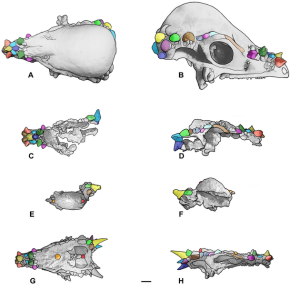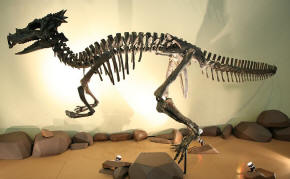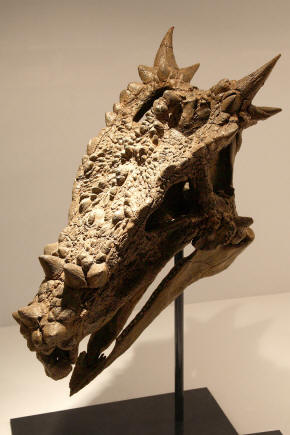|
However,
Jack Horner et al.
suspect that it is a juvenile
Pachycephalosaurus.
Now, a new analysis of pachycephalosaur fossils by a joint team from the
University of California, Berkeley and the Museum of the Rockies has
questioned the validity of two named genera of pachycephalosaur,
Dracorex and
Stygimoloch.
According to the team, specimens of
Dracorex and
Stygimoloch might actually
represent earlier growth stages of
Pachycephalosaurus. As this article on the UC
Berkeley website says, "The confusion is traced to their bizarre head
ornaments, ranging from shields and domes to horns and spikes, which changed
dramatically with age and sexual maturity, making the heads of youngsters
look very different from those of adults."
Description
Dracorex,
a herbivore, had a skull
with spiky horns, bumps, and a long muzzle. The species also sports
well-developed supratemporal
fenestrae and a heavily
armored flat skull—lacking the characteristic pachycephalosaurid dome.
Coupled with these two features is the excessive number of osteoderms in the
form of irregular osteodermal crust: a number of nodes, larger hornlets, and
spikes. Disregarding this, Dracorex
is physically comparable to
Stygimoloch.
In the Pachycephalosauridae, the
Asian taxa includes a
number of (somewhat) flat-headed pachycephalosaurs (Homalocephale
calathocercos,
Goyocephale lattimorei,
and
Wannanosaurus yansiensis).
However, prior to the discovery of Dracorex,
the only semi-flat-headed pachycephalosaur from
North America was
Stegoceras validum
(inclusive of
Ornatotholus browni).
Even then, the semi-flat-headed trait was only present in juveniles of the
species.
Aside from having a flat, nodal
skull, the most prominent feature of Dracorex
is the pair of huge and unrestricted superior temporal openings. The
supratemporal fenestrae are much larger front-to-back and side-to-side than
in Homalocephale,
and larger than in Goyocephale.
Only a fragmentary Wannanosaurus
skull shows fenestrae as large as those of
Dracorex. This fenestral architecture has been
seen in ancient
archosaurs, but not in
other pachycephalosaurs.
Consequently, if unreduced superior
fenestrae are
morphologically
primitive, then Dracorex
is more primitive in the temporal region than any other known
pachycephalosaur. However, Sullivan (2003, 2006) demonstrated that the
oldest known pachycephalosaurs were, in fact, fully domed, and that the
flat-headed morphology appeared later in the fossil record. This suggests
that doming may be primitive for pachycephalosaurs and that a
reversion to the
non-domed, flat-headed state is a secondary (derived) character reversion,
coupled with the re-opening of the supratemporal fenestrae. Indeed, while
Stegoceras has been
considered to be transitional between domed and flat-headed taxa, it may
indicate the beginning of a character reversion to suppression of doming and
opening of the supratemporal fenestrae in some taxa.
The excavated specimen was most
likely a young adult. However, based on the beginning of
ossification of the
mid-cervical arch with the
centrum, it was near
maturity. The animal was approximately 10 feet (3 m) long.
Classification
Dracorex
may actually be an individual of the closely related
Stygimoloch and/or
 |
Diagram showing
Dracorex and
Stygimoloch
as growth stages of
Pachycephalosaurus.
The ontogenetically oldest adult, AMNH 1696,
in (A) dorsal and (B) right lateral views. A younger adult, UCMP
556078 (cast) with inflation of the frontoparietal dome+lateral
cranial elements and mature nasal and squamosal nodal ornamentation
in (C) dorsal and (D) right lateral views. MPM 8111, a partial skull
of "Stygimoloch" in (E) dorsal and (F) left lateral views (reversed)
illustrates the high narrow frontoparietal dome, squamosal nodes and
horns characteristic of the subadult growth stage. Landmarks on the
dorsal skull of MPM 8111 in orange (anterior) and red (posterior)
constrain the position of the dome. The youngest growth stage in
this cranial ontogenetic series is "Dracorex", TCNI 2004.17.1 (cast)
in (G) dorsal and (H) right lateral views. The position of the
squamosal horns and nasal nodes are consistent in these four
pachycephalosaurid skulls, which increase in overall length and size
from youngest (G,H) to oldest (A,B). (Picture
Source) |
Pachycephalosaurus in
which the dome and horns are not well-developed, either because the animal
was a juvenile or a female. This consideration was supported at the 2007
annual meeting of the Society of Vertebrate Paleontology. Jack Horner of
Montana State University
presented evidence, from analysis of the skull of the single existing
Dracorex specimen, that
this dinosaur may well be a juvenile form of
Stygimoloch. In addition, he presented data that
indicates that both Stygimoloch
and Dracorex may be
juvenile forms of Pachycephalosaurus.
Horner and M.B. Goodwin published their findings in 2009, showing that the
spike/node and skull dome bones of all three 'species' exhibit extreme
plasticity, and that both Dracorex
and Stygimoloch are
known only from juvenile specimens while
Pachycephalosaurus is known only from adult
specimens. These observations, in addition to the fact that all three forms
lived in the same time and place, lead them to conclude that
Dracorex and
Stygimoloch may have
simply been juvenile Pachycephalosaurus,
which lost spikes and grew domes as they aged. The researchers were unable
to destructively sample the Dracorex
skull, and had to use a cast of the skull for descriptive purposes. A 2010
study by Nick Longrich and colleagues also supported the hypothesis that all
flat-skulled pachycephalosaurs were juveniles, suggesting that flat-skulled
forms like Goyocephale
and Homalocephale
represent juveniles of dome-skulled adults.
Name
The name
Dracorex hogwartsia was
inspired by young visitors to the Children's Museum of Indianapolis
as a tribute to both dragons (Dracorex
means "dragon king"), which the animal resembled, as well as the
Harry Potter series of
books by J.K. Rowling (hogwartsia
for the Hogwarts School of Witchcraft and Wizardry,
the fictional school from the popular series).
In Popular Culture
Dracorex
is not very well known in popular culture but it has made an appearance in
ITV's cult sci-fi drama
Primeval, in which it
escaped from the Cretaceous into medieval England. A knight mistook it for a
dragon and tried to kill it, and even followed it into the present-day era,
causing general chaos. However, Dracorex
was depicted with exaggerated horns and a pair of fins along its back that
are not found in the fossil record.
If you ordered the Test Pack, it is now time to
take Test 8.
Return to the
Old Earth Ministries Online Dinosaur
Curriculum homepage.

Shopping
Bay
State Replicas - Skull
Black
Hills Institute - None
|


